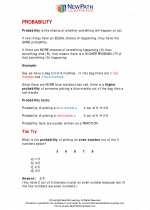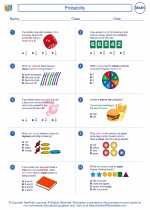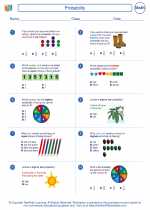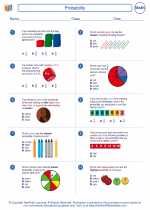Probability
Probability is a branch of mathematics that deals with the likelihood of a particular event or outcome occurring. It is used to quantify uncertainty and measure the likelihood of various outcomes.
Basic Concepts
- Sample Space: The set of all possible outcomes of an experiment. For example, when rolling a six-sided die, the sample space is {1, 2, 3, 4, 5, 6}.
- Event: A subset of the sample space. An event can consist of a single outcome or multiple outcomes. For example, getting a 3 when rolling a six-sided die is an event.
- Probability of an Event: The likelihood of an event occurring, often denoted by P(event). It is a number between 0 and 1, where 0 indicates impossibility and 1 indicates certainty.
Calculating Probability
The probability of an event can be calculated using the following formula:
P(event) = Number of favorable outcomes / Total number of outcomes
Types of Probability
There are different types of probability, including:
- Classical Probability: Based on equally likely outcomes. For example, the probability of rolling a 3 on a fair six-sided die is 1/6.
- Empirical Probability: Based on observed data. For example, the probability of a team winning a game based on its past performance.
- Conditional Probability: The probability of an event occurring given that another event has already occurred. It is denoted by P(A|B), where A and B are events.
- Complementary Probability: The probability of an event not occurring. It is calculated as 1 minus the probability of the event occurring.
Study Guide
To study probability effectively, consider the following tips:
- Understand the basic concepts of sample space, event, and probability.
- Practice calculating probabilities using the formula Number of favorable outcomes / Total number of outcomes.
- Learn about the different types of probability and how they are applied in real-world scenarios.
- Work on solving probability problems and applying the concepts to various situations.
- Review and understand conditional probability and complementary probability.
By mastering the concepts and calculations of probability, you will be better equipped to analyze and make decisions based on uncertain outcomes.
[Probability] Related Worksheets and Study Guides:
.◂Math Worksheets and Study Guides Fourth Grade. Probability
Study Guide Probability
Probability  Worksheet/Answer key
Worksheet/Answer key Probability
Probability  Worksheet/Answer key
Worksheet/Answer key Probability
Probability  Worksheet/Answer key
Worksheet/Answer key Probability
Probability 

 Worksheet/Answer key
Worksheet/Answer key
 Worksheet/Answer key
Worksheet/Answer key
 Worksheet/Answer key
Worksheet/Answer key

The resources above cover the following skills:
Number and Operations (NCTM)
Understand numbers, ways of representing numbers, relationships among numbers, and number systems.
Develop understanding of fractions as parts of unit wholes, as parts of a collection, as locations on number lines, and as divisions of whole numbers.
Algebra (NCTM)
Use mathematical models to represent and understand quantitative relationships.
Model problem situations with objects and use representations such as graphs, tables, and equations to draw conclusions.
Data Analysis and Probability (NCTM)
Understand and apply basic concepts of probability.
Describe events as likely or unlikely and discuss the degree of likelihood using such words as certain, equally likely, and impossible.
Understand that the measure of the likelihood of an event can be represented by a number from 0 to 1.
Connections to the Grade 4 Focal Points (NCTM)
Number and Operations: Building on their work in grade 3, students extend their understanding of place value and ways of representing numbers to 100,000 in various contexts. They use estimation in determining the relative sizes of amounts or distances. Students develop understandings of strategies for multi-digit division by using models that represent division as the inverse of multiplication, as partitioning, or as successive subtraction. By working with decimals, students extend their ability to recognize equivalent fractions. Students' earlier work in grade 3 with models of fractions and multiplication and division facts supports their understanding of techniques for generating equivalent fractions and simplifying fractions.